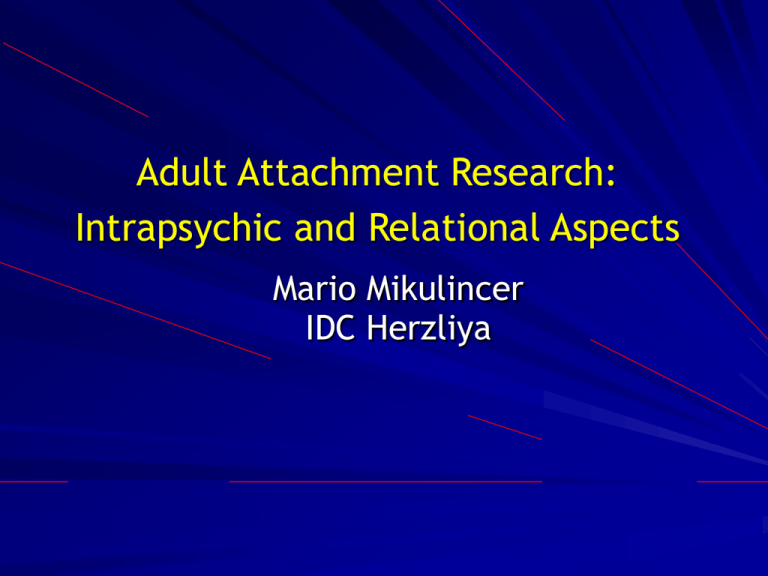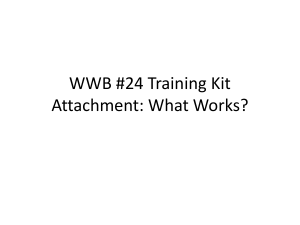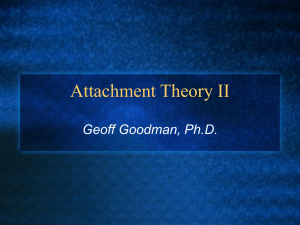
Adult Attachment Research:
Intrapsychic and Relational Aspects
Mario Mikulincer
IDC Herzliya
Overview
Goal: To convey some of what we and our colleagues and
students have learned while pursuing an adult extension of
Bowlby and Ainsworth’s attachment theory
Brief background: attachment theory and its extension into
the field of close relationships research
Our model of attachment-system activation and functioning
in adulthood
Sample research on working models, attachment-system
activation, emotion regulation in behavior and the brain,
and couple relationships
Attachment theory
distilled
Humans, especially infants, rely on attachment figures for
protection, support, and help with emotion regulation
The attachment behavioral system is an evolved, innate
regulator of proximity (hence of safety and safe exploration)
When threats abate, behavioral systems other than
attachment (e.g., exploration, caregiving) can be activated,
allowing a person to become more competent/autonomous
Attachment orientations, or “styles,” develop in
relationships, resulting in systematic individual differences in
attachment orientation: secure, anxious, avoidant, . . .
The theory applies from “the cradle to the grave” (Bowlby)
Adult attachment ‘styles’ in social/personality
psychology: Regions in a two-dimensional space
HIGH AVOIDANCE
DISMISSING AVOIDANT
FEARFUL AVOIDANT
LOW ANXIETY
HIGH ANXIETY
SECURE
PREOCCUPIED
LOW AVOIDANCE
Adapted from Ainsworth et al. (1978), Bartholomew
& Horowitz (1991), Fraley & Shaver (2000)
Self-report attachment measure
(Brennan, Clark, & Shaver, 1998)
Avoidance (18 items, > .90)
1. I prefer not to show a partner how I feel deep down.
2. I try to avoid getting too close to my partner.
3. I feel comfortable depending on relationship partners. (reversescored)
4. I turn to a relationship partner for many things, including
comfort and reassurance. (reverse-scored)
Anxiety (18 items, > .90)
1. I don’t often worry about being rejected or abandoned.
(reverse-scored)
2. I need a lot of reassurance that I am loved by a partner.
3. I get frustrated if a relationship partner is not available when
needed.
4. I resent it when a partner spends time away from me.
Since Hazan & Shaver (1987) . . .
Hundreds of studies
using self-report
attachment measures
have been conducted
The findings can be
summarized in a
three-part model
(Mikulincer & Shaver,
2007, and elsewhere)
+
-
Signs of
threat?
Activation of
other behavioral
systems
No
Yes
Attachment-system activation
+
Is attachment figure
available?
-
Yes
No
Insecurity, distress compounding
Is proximity
seeking a viable
option?
Yes
Hyperactivating strategies
No
attachment
security,
distress
alleviation
Securitybased
strategies
Deactivating strategies
Aspects of the theory to be considered
in this talk
Mental representations of self and others
(Bowlby’s “internal working models”)
Attachment system activation in the lab
Attachment insecurities and emotion regulation
Relational ambivalence
Attachment, caregiving, and sex in couple
relationships
First Issue
Attachment Insecurities and Mental
Representations of Self and Others
Attachment insecurities
and dreams
(Mikulincer, Shaver, & AvihouKanza, A&HD, 2011)
Sample secure dream
Reported by a young woman who scored low on both the anxiety and
avoidance scales of the ECR, and whom regard as secure:
I was sitting in my elementary school library reading a book, which
seemed very natural even though I haven’t been there for years. I spoke
with friends and teachers, and the place was just as it used to be. The
principal came in and started yelling at us, saying we were barbaric
children. At first I thought we might have been noisy and deserved this
rebuke, but I told him that, despite whatever bad behavior we engaged
in, we didn’t deserve such treatment and he had overlooked my many
good qualities. I felt that despite being a little girl, I had enough selfesteem to tell him he was wrong. So I got up and told him I was not a
barbarian and I came to the library to read books that I like. He then
apologized. I felt proud of myself. At that instant, my mom appeared,
hugged me, and said I was okay and she was also proud of me. (I don’t
know how my mom got there.) She then took me to some fun place; I
don’t know where. I just remember that we laughed a lot and bought
some silly things – maybe in a mall.
Sample anxious dream
Reported by a young man who scored high on attachment anxiety:
I’m arguing with friends about who teaches a particular course. I start
running toward the city and see a bank robbery in progress. Suddenly I
realize that I am the bank robber! I’m debating with myself about
whether I should break into the bank or not, and I decide that I should. I
get into the bank and yell, “Give me the money!” The teller stoops
down below the counter, gets the money, and hands it to me, and I run
away. While exiting the bank, I shoot three times in the air and then run
down the street with the weapon wrapped in a quilt. While running, I
suddenly think about what I’ve done and what a bad person I am:
“Maybe I hit someone while shooting in the air.” I’m debating with
myself about where to run and suddenly notice that the money has
disappeared. I think, “Why can’t I do something right for once?” I want
to cry. Suddenly the cops arrive. I say, “Take me. Maybe it’s for the
best that I go to jail. No one cares about me anyhow.” I feel really
ashamed of what I did. Suddenly my dad appears and yells at me: “How
dare you do such a foolish thing! You deserve to go to jail. You’re
worthless.” It hurts, but I know that what he says is true.
Sample avoidant dream
Reported by a young woman who scored high on avoidant attachment:
My parents wanted me to go with them to my grandma’s house, and a
discussion ensued about whether it was worth going and if she would or
wouldn’t have food for us. I said I didn’t want to go, and I went into the
backyard alone. There was a “cat party” going on, and many disgusting,
filthy black cats were sitting in a circle, facing out, with their backs
toward each other. Every cat screamed, one at a time, and if the cat
opposite to that one correctly identified the screamer, that cat won. I sat
in the corner with my computer and was afraid to move. I thought, “Why
didn’t they run away when they saw me?” I realized that because there
were so many of them, they knew they had power over me and could
easily wipe me out. Suddenly, my computer fell and landed close to the
cats. I had to save it, so I got closer to them, but when I did, they jumped
on the computer and threatened me with aggressive expressions and
horrible screams. They started to sing, “If you don’t go home, you’ll have
to tell us who is a nice cat.” I had to answer with a song saying that all of
them were nice. They then let me have my computer. I wanted to destroy
them one by one, but instead I went inside with the computer . . . and
woke up in terror.
Knowledge of the
“secure-base script”
(Mikulincer, Shaver, et al.,
JPSP, 2009)
What is inside the secure person’s mind
THE SECURE BASE SCRIPT
If I encounter an obstacle and/or become distressed
I can approach a significant other for help
He or she is likely to be available and supportive
I will experience relief and comfort as a result of
proximity to this person
I can then return to other activities
2
What is inside the avoidant person’s mind
THE SECURE BASE SCRIPT
If I encounter an obstacle and/or become distressed
I can approach a significant other for help
He or she is likely to be available and supportive
I will experience relief and comfort as a result of
proximity to this person
I can then return to other activities
2
What is inside the anxious person’s mind
THE SECURE BASE SCRIPT
If I encounter an obstacle and/or become distressed
I can approach a significant other for help
He or she is likely to be available and supportive
I will experience relief and comfort as a result of
proximity to this person
I can then return to other activities
22
Insecure scripts
(Ein-Dor, Mikulincer, Shaver, &
Doron, JPSP,in press)
Sentinel script
Rapid fight-flight script
Second Issue:
Attachment System Activation
(in the Lab)
The attachment system
can be unconsciously
activated
(Mikulincer et al.,
JPSP, 2000, 2002)
(Sample fixation point,
shows for 500 milliseconds)
X
X
(subliminal, invisible prime word,
shown for 22 ms and then masked)
death
(visible target name)
Moshe
(stays visible until the person presses a
key indicating it is either a word or not a
word: e.g., oshme)
Time taken to indicate that letter
strings are words (names)
milliseconds
620
600
580
560
540
520
500
480
460
440
*
Threat
Neutral
Names of
Attachment Figures
Names of Close
Persons
Names of Known
Persons
* = a significant difference
Third Issue:
Emotion Regulation
Avoidant attachment and
emotion regulation
Avoidant individuals inhibit or block
emotional states
Avoidant inhibition require mental effort,
and hence can be over-ridden by cognitive
load and stress
Two examples . . .
Color-naming times (in msec) for separation
words during a Stroop task
700
675
650
625
600
High Load - Low
Avoid
Low Load - High
Avoid
Low Load - Low
Avoid
High Load - High
Avoid
575
Control
Suppression
Avoidant people showed no “rebound” of separationrelated thoughts when not under a high cognitive load,
but they couldn’t avoid the rebound under a high load
(Mikulincer, Dolev, & Shaver, JPSP, 2004)
A real-world example:
Mothers with a CHD child
(Berant, Mikulincer, & Shaver,
JP, 2008)
Attachment anxiety and
intensification of emotion
Anxious individuals seem unable (or
unwilling?) to suppress negative emotions
To learn more about their intense
emotionality, we have used neuroimaging
techniques (fMRI)
Regions in which attachment anxiety correlates
.74**/.64** with activation during thoughts of loss
(Gillath et al., NeuroImage, 2005)
L
Left anterior temporal pole
associated with recall of sad
thoughts (Lévesque et al., 2003)
activation during negative thoughts
(Think Negative > Think Neutral) was
correlated with attachment anxiety
(r = .74**)
Left hippocampus
associated with memory retrieval (Eichenbaum, 2004)
activation during negative thoughts was correlated
with attachment anxiety (r = .64**)
R
Fourth Issue:
Attachment Insecurity and
Relational Ambivalence
Experimental studies
of relational
ambivalence
(Mikulincer, Shaver, Bar-On,
& Ein-Dor, JPSP, 2010)
Study 1 - Results
β Anxiety
β Avoidance
Explicit ambivalence
.49**
-.06
Implicit ambivalence
toward closeness words
.28**
.01
Implicit ambivalence
toward distance words
.24*
.11
Measure
Notes: * p < .05; ** p < .01
Study 2 – Method
90 Israeli students completed the ECR scale and
interacted with an opposite-sex confederate and
were randomly divided into three conditions:
–
(a) Liking
–
(b) Rejection
–
(c) Control
Participants then completed the approachavoidance task used in Study 1, assessing implicit
ambivalence toward closeness and distance words.
Study 2 – Results for ambivalence
toward closeness words
The link between attachment anxiety and
implicit ambivalence toward closeness words was
significant in the liking and the rejection
condition, but not in the control condition.
Additional analyses revealed that being liked or
rejected by the confederate created greater
ambivalence toward closeness words when
attachment anxiety was relatively high, but not
when it was relatively low
Study 2 – Results for ambivalence
towards distance words
Attachment anxiety was slightly associated with
implicit ambivalence toward distance words.
Avoidant attachment was associated with implicit
ambivalence toward distance words only in the
rejection condition.
That is, the experience of a potential relationship
partner’s rejection caused the more avoidant
participants to react to distance words with
greater implicit ambivalence (reminiscent of our
earlier finding for the word “separation” in the
lexical decision study).
Fifth Issue:
Couple Relationships
Romantic love (couple pair-bonding) can be
conceptualized as the integration of 3 behavioral
systems discussed by Bowlby: attachment,
caregiving, and sex
Attachment
Pair
bonding
Hazan and Shaver
(1987)
Attachment and sex
Many studies have shown that attachment anxiety and
avoidance are related to sexual motives, fantasies, and
behavior (e.g., Schachner & Shaver, 2004)
Gurit Birnbaum will present a review of the attachmentsex link in her lecture
Attachment and caregiving
Many studies have shown that attachment anxiety and
avoidance are related to deficits in caring for relationship
partners and engaging in altruistic behavior (e.g., Kunce
& Shaver, 1994; Gillath et al., 2005).
Anxious people tend to be self-focused in supposedly
caring/altruistic actions, leading to intrusiveness, poor
assessment of others’ actual needs, and personal
distress.
Avoidant people tend to be less interested in helping
others and to derogate needy others.
Current project: Overcoming barriers to
support in couples (in Israel and Davis)
In previous projects we found that manipulations aimed
at causing people to feel more secure, temporarily,
increased compassion and altruism for a suffering
stranger.
Now we are interested in discovering whether these
desirable effects can be extended to couple relationships
and situations in which one partner is in the role of
listener and supporter with respect to the other partner.
We also want to see whether security priming can
overcome barriers (e.g., fatigue or distraction) to
effective care of a partner.
Experimental Design
Participants: Young couples in Israel and US. One
member acted as caregiver, the other as
careseeker
Manipulated variables:
– Caregiver’s security priming (yes ,no)
– Caregiver’s cognitive depletion (yes, no)
Dependent variables:
– Observers’ ratings of caregiver’s responsiveness
and supportiveness while listening to his or her
partner’s disclosure about a personal problem
Means of Caregiver’s Responsiveness in the Total Sample,
Broken Down by Priming and Depletion Conditions
5.5
5
4.5
Depletion
Control
4
3.5
3
Security
Priming
Neutral Priming
F(1, 205) = 6.09, p < .01
Means of Caregiver’s Responsiveness in the American
Sample According to Priming and Depletion Conditions
5
4.5
4
Depletion
Control
3.5
3
Security
Priming
Neutral Priming
F(1, 127) = 3.93, p < .05
Means of Caregiver’s Responsiveness in the Israeli
Sample According to Priming and Depletion Conditions
6
5.5
5
4.5
Depletion
Control
4
3.5
3
Security
Priming
Neutral Priming
F(1, 127) = 4.21, p < .05
Thanks
mario@idc.ac.il






